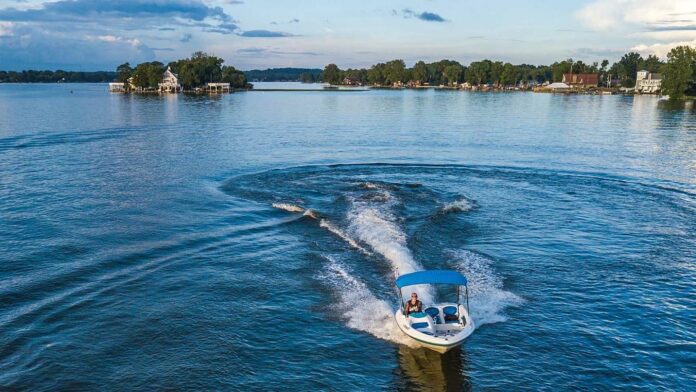Getting to Know the Largemouth Bass
The largemouth bass is a freshwater gamefish. They are olive-green to greenish-gray in color with a series of dark, sometimes black, blotches forming jagged horizontal stripes along each flank. This bass has a large mouth that extends beyond the rear edge of the eye. This characteristic distinguishes it from the smallmouth and spotted bass. The largemouth bass is the largest of the black basses and is typically 15-18 inches and between 1-5 pounds. In Ohio, the bass can reach up to 26 inches and 13 pounds. Their average lifespan in the wild is 10 to 16 years. They usually reach sexual maturity and begin to spawn around one year of age. Spawning occurs in the spring when the water temperature remains about 60°F for an extended period. Bass will usually spawn twice per spring. Largemouth bass are apex predators as adults; however, they are preyed upon by many animals while young. As adults, they are targeted by the bald eagle.
Catch and Release

In Ohio, the largemouth bass is one of the most popular fish and can be caught in ponds, streams, rivers, and nearly all inland lakes and reservoirs. Growing up on the river, I spent many days with my brother fishing for these giants. Before we would head out, we would spend a good amount of time turning over rocks looking for crawdads to use as bait. That was always a good time in itself, as crawdads are not always as easy to catch as one might think, especially when you are as young as we were. Bass are highly sought after by tournament fishermen and anglers across the state because it allows them to transform their hobby into competition fishing. These game fish are known for their "fight" and explosive force once hooked. Often becoming airborne in an effort to throw the hook. When fishing for this bass you can use a wide variety of lures such as spinnerbaits, plastic worms, jigs, crankbaits, and live bait, such as worms, minnows, frogs, or crawfish. When fishing for largemouth in the spring dark-colored baits work well, while lighter colors are best in the fall. It is a common practice to catch and release this bass, especially when they are larger because they are usually breeding females that heavily contribute to future sport fishing stocks. The largemouth bass responds well to catch and release and has a very high survival rate unless they have swallowed the hook. They can adapt to many environments but prefer relatively clear non-flowing waters with some aquatic vegetation. They are also most often found close to cover, near submerged trees, vegetation, docks, bridges, or changes in bottom depth.
While we "threw back" our fair share of largemouth, we certainly were able to have a few good fish fries every year. It felt nice to know we could contribute to our family by catching dinner every now and then.
Fishing Tournaments
Anywhere you can find good fishing, chances are there are tournaments taking place. There are bass tournaments for all skill levels, from beginners to professionals. In local or amateur bass tournaments, anglers normally compete in teams of two. This format is an excellent opportunity for anglers to work together and develop their angling skills. The amateur, or co-angler, is a randomly assigned tournament where the individual fishes from the back of a pro's boat and only competes against other co-anglers. The mid-level, or triple-A events, use a "pro-am" format. The "pro" or boater, fishes from the front of their boat and competes against other pro anglers. In most professional tournaments, anglers compete individually competing for prizes as well as season-long angler-of-the-year titles and championship qualifications. Before you plan on entering any of these tournaments, you will want to familiarize yourself with the logistics and rules. The rules are created to maintain a safe and fair competition. Some of the rules you will need to follow are:
- Type of boat and size
- Legal methods of fishing
- Safety Protocols
- Boundaries of the competition
- Licensed to fish in the state where competing
Prior to launching on tournament day, officials will check anglers and their boats to verify their livewells are functional and empty, that the angler is wearing a life jacket, and that the engine cut-off switch is attached and working. Anytime your boat engine is running, you are required to wear your life jacket. If you have questions or concerns regarding a specific tournament, the tournament directors are a great resource.
Buckeye Lake and Caesar Creek Open
 Buckeye Lake
Buckeye Lake
 Caesar Creek
Caesar Creek
Vance Outdoors has hosted the Buckeye Lake Open fishing tournament since 2014. Buckeye Lake is a 3,100-acre lake with a 4-mile shoreline connecting the North Shore to Lieb's Island. The park offers a variety of areas for fishing and relaxation. The success of these past tournaments has enabled Vance Outdoors to expand its reach to Caesar Creek last year. Caesar Creek is a 2,830-acre lake with all the amenities for a great day on the water. If you are looking for an excuse to get out there and get some bass, here is your chance! Stop by your local Vance Outdoors where you can find everything you will need to prepare for these tournaments, and eager and friendly staff to help with your shopping experience. For more information about the tournaments visit Vanceoutdoors.com.